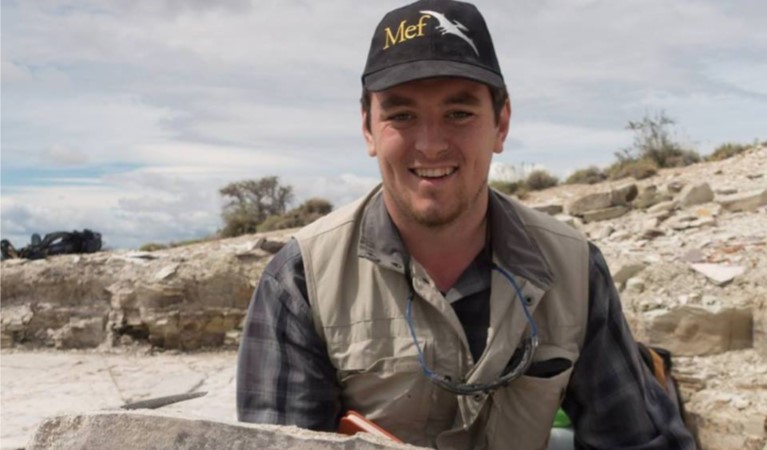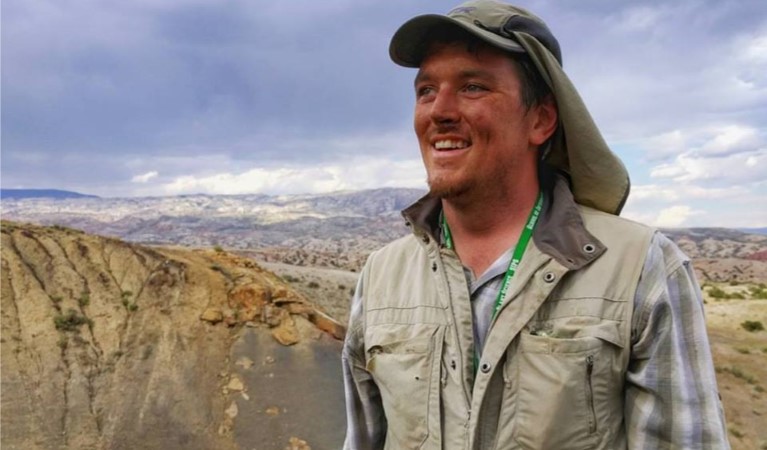
Collecting fossils in an Eocene Caldera Lake deposit in Patagonia, Argentina (photo credit: Peter Wilf)
Editor’s Note: The Happy Beginnings series features recent College of Arts & Sciences graduates who are getting started in careers, graduate school and service.
By MC Tilton, PACE Writer
Ohio University alum Nathan Jud’s passion for fieldwork and fossils has taken him on a pathway through the Smithsonian, the Panama Canal, and most recently to the tip of South America.
More than 20 journal articles help chronicle his discoveries as he gains momentum in the world of paleobotany. He is currently doing post-doctoral studies with Cornell University, exploring Argentinian Patagonia, the region at the southern end of South America, in search of plant fossils and the story they tell of diversification across ancient landscapes. He is working in the Paleocene epoch, some 66 to 56 million years ago, which began with the end-Cretaceous mass extinction event, or the demise not just of the non-avian dinosaurs but of many flora as well, and ended with a period of global warming.
Jud earned a B.S. in Environmental & Plant Biology from the College of Arts & Sciences in 2007, followed by a Ph.D. from the University of Maryland’s Program in Behavior Ecology Evolution and Systematics.
His areas of expertise include plant anatomy and morphology, paleoecology, sedimentology, and phylogenetic analysis, and he is an author of publications in journals such as Nature and the American Journal of Botany.
Making New Discoveries
“My favorite part of my job and studies right now is fieldwork. I love exploring and collecting new fossils – making new discoveries and handling things that have never been seen before. I’m working with plants from Argentinian Patagonia right now, and the opportunity to travel there has been a lot of fun,” Jud says.
“But the most rewarding part of the job is seeing people light up – especially students and museum goers – when they find out what makes plants so fascinating and important,” he says.
“When I graduated from OHIO, I decided to go to grad school. I applied to Maryland so that I could work with researchers at the Smithsonian. Fortunately, I got to spend several years in Washington, D.C., working on plant fossils from Virginia and Wyoming, doing lots of fieldwork, and networking with amazing scientists who would visit the collections,” he says.
“From there I went to a post-doc at the University of Florida where I was part of a Panama Canal project. It was an important stage of my career where I went from being a student to being a mentor in a significant way. Mentoring has since become a big part of my career, and I really enjoy helping students get museum and research experience.
“Since I left Florida, I’ve spent my time working on the Patagonia Paleofloras Project, where I am part of a collaborative effort to collect, describe, and interpret plant fossils from the Paleocene rocks of Argentina. I’m currently applying to academic positions, which feels like the crux of my career,” Jud says.
“My research interests are focused primarily on ecological changes associated with the diversification of flowering plants – how they came to be and how their diversification was carried across the ancient landscapes. I’m addressing these questions primarily through fieldwork, because the answers are out there waiting to be found.”
Starting with Undergraduate Research at OHIO
“My undergraduate research at OHIO sent me down this career path. I did research in several fields, including paleobotany with Dr. Rothwell, genetics, and some classroom-integrated ecology research. That was by far the most important factor in setting up my path for academia and more research,” Jud says.
“I have several faculty mentors to thank. They were instrumental in getting me to present the results of my work in lab meetings and at national meetings and other conferences, where I learned that this career path was a real possibility and that I could succeed.”
“There were certainly ways in which OHIO prepared me for grad school that were really special,” he says.
Jud says he took a biology class in high school with a former ethnobotanist who inspired an interest in plants and their evolutionary history. He started out at OHIO as a biology major. “But I ended up switching to plant biology in my freshman year because of how much I enjoyed the classes and colloquiums I attended. It seemed like a positive environment where I would be supported by my peers and professors, and it was.”
As an undergraduate at Ohio University, Jud says on his Botanical Society of America web page, “I had the opportunity to work in the Paleobotanical Herbarium. I began by cleaning out drawers and filing papers, but every drawer was full of fossils that offered a glimpse into the history, which was enough to keep me going until I began my first research project.
“My first research project involved describing a fossil fern and interpreting its significance. I received a grant from an Ohio University undergraduate research fund to present my results in Chicago for the Botanical Society of America’s Botany 2007 meeting. There, I had the opportunity to meet other botany students and researchers during the various presentations and field trips. That experience helped me understand that I really could have a career in as unique a field as paleobotany. During my senior year I took on a second research project, and in 2008 I traveled to the Cretaceous deposits of Vancouver Island, British Columbia to visit the site where the objects of my research were collected, and to make new collections.”
The Environmental & Plant Biology Department at OHIO provided classes and research opportunities that “weren’t things that all the other first-year graduate students had, so now I really appreciate the value of having a plant biology department. The emphasis on presentation skills, communication, and writing were invaluable – plus there were opportunities in the department and at regional and national meetings to present,” Jud says.
“I don’t think I realized at the time how important those experiences would be,” Jud says. “I also participated in a research experience for undergrads program at Colorado State University and a study abroad in the Bahamas with Harvey Ballard, and those were really important. I always encourage students to take advantage of those types of opportunities.”

Surveying the geology of the Cretaceous Cloverly Formation in Wyoming (photo credit: Sarah DeWitt)
“I will always remember my trips to visit Harold Blazier at the greenhouse with his incredible collection, and he was such a great guy. I also really enjoyed the teaching gardens, where I took my alternative agriculture class. There’s nothing like getting out of the classroom and really delving hands-on into what you study every day,” Jud adds.
Advice to Current Students
“I would say don’t shy away from challenging classes, study abroad opportunities, or research. You have to see the challenge and go for it – that’s where you will grow the most,” Jud says. “I tried to do too much, but that was still important in the end for learning what my limits were. I also think I shied away from some challenging experiences early on, which is why I give that advice now.
“The biggest challenge for me has been that in college, you train for the research and learn the material, but there’s so much more expected of you at every stage in your career. I’ve had to sharpen my skills in writing, communicating, job applications, and teamwork, which you don’t always get to develop until you’re in the thick of it. I love this field, so I’m fortunate that I have been able to meet those challenges, but there’s so much more expected of you than just knowing the material, and learning to meet those expectations is a process.”



















Comments